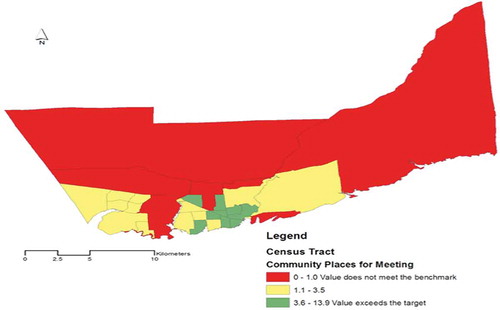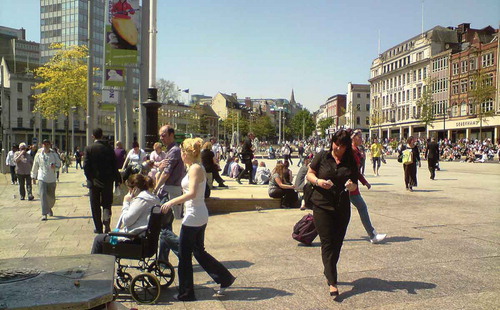CITY KNOW-HOW
Human health and planetary health are influenced by city lifestyles, city leadership, and city development. For both, worrying trends are leading to increasing concern and it is imperative that human health and environmental impacts become core foci in urban policy. Changing trajectory will require concerted action; the journal Cities & Health is dedicated to supporting the flow of knowledge, in all directions, to help make this happen. We wish to foster communication between researchers, practitioners, policy-makers, communities, and decision-makers in cities. This is the purpose of the City Know-how section of the journal. ‘Research for city practice’ disseminates lessons from research by explaining key messages for city leaders, communities, and the professions involved in city policy and practice. ‘City shorts’ provide glimpses of what is being attempted or achieved ‘on the ground’ and ’case studies’ are where you will find evaluations of interventions. Last, ‘Commentary and debate’ extends conversations we are having to develop and mobilize much needed new thinking. Join in these conversations. In order to strengthen the community of interest, we would like to include many and varied voices, including those from younger practitioners and researchers who are supporting health and health equity in everyday urban lives.
Marcus Grant
Editor-in-Chief, Cities & Health
Lindsay McCunn
Commissioning Editor, Cities & Health
In this issue of Cities & Health, we are proud to announce the launch of a new section of the journal called ‘Reflections from research, practice, and design.’ Our aim for this section is to encourage submissions that cover the diverse range of issues of interest to built environmental professionals and community organizations. We make space for scholarly researchers to share important lessons from experience that lie outside the typical ‘research project’ write-up. The need for this section, and the reasoning behind its development, is discussed in more depth in a leading editorial by board members Marcus Grant and Susan Thompson. The editorial board wishes for Cities & Health to provide a platform for new voices in addition to, and in collaboration with, academia. Therefore, we welcome submissions from those who are working on building principles and practices that help make towns and cities healthier places. Such individuals and groups may be:
Architects, landscape architects, and urban designers who are heavily involved in shaping places, that, in turn shape people’s lives.
Practitioners working in politics and policy, planning, urban transport, and housing development who have a wealth of experience concerning what works when developing and maintaining healthier and more inclusive towns and cities.
Diverse and global communities that are spearheading small- to medium-scale projects to obtain inclusion and a better quality of life.
Please get in touch with us and submit articles to use Cities & Health as an avenue to contribute reflections on your experiences with building and managing healthier urban spaces and places. Tell us how those experiences have influenced your understanding and your ongoing practices. Substantial scholarly papers and briefer think-pieces are both welcome.
In this issue, we publish our first four reflective papers, three think-pieces, and one longer paper. In the first of the shorter papers, Shaleen Miller reflects on a project that she was involved with in Puerto Rico following Hurricane Maria. She examines how we may find (or even create) opportunities to collaborate with each other amidst disaster. Next, Alana Crimeen and her co-authors extend the healthy setting approach to airports. They pose important questions about these vital and ubiquitous infrastructures in relation to health. Can there be a research strategy for planning healthier airports in the future? Finally, Emily Flies leads a group of authors in publishing a novel and timely paper about urban microbiome initiatives in relation to cities, biodiversity, and health.
The longer paper in this reflective section is by Greg Paine and a group in New South Wales, Australia. They present lessons from a cross-disciplinary study of residential areas as they sought to understand actual lived experiences of what may be considered as a health-supportive built environment. Their paper reflects on the importance of ensuring that built environment professionals themselves implement and maintain health-supportive features that are initially proposed in development schemes. They also argue for the provision of ongoing support to assist in the uptake of these features by residents. We are pleased to publish these first four papers in this new reflective section. Indeed, this section of Cities & Health is still very much in development and we look forward to your involvement in enhancing it.
Also in this issue, we publish a case study a ‘City Short,’ along with a commentary and four major scholarly articles. In the case study, Hanna Negami and co-authors from the University of Waterloo and Happy City Vancouver report on a field analysis of some psychological effects of urban design in Vancouver. The ‘City Short,’ written by Mark Scott and team at the School of Architecture, Planning and Environmental Policy at University College Dublin, affords an account of centralising health in national spatial planning frameworks in Ireland. The commentary from Russell de Souza and a multi-disciplinary team describes the development of an online interactive map to display environmental health assessments of Canadian communities. This article will be useful for those wanting access to this tool, which is also the subject of an empirical paper from the same group publishing their substantive results. Taking snapshots of 2,074 rural and urban communities across Canada, their main paper explores local risk factors associated with cardiovascular disease and cancer. They assessed demography, public transport, availability and prices of tobacco, groceries, and alcohol and healthful restaurants in order to report on a number of relationships. The online tool allows further exploration of these relationships.
Continuing the Canadian element in this issue, in a methodological paper, Kyle Pakeman and Patricia Collins discuss the benefits and drawbacks of using the World Health Organization’s Urban HEART tool in a non-metropolitan context. The tool helps to explore socio-spatial inequities and has been designed for, and tested in, a number of large cities. Here, the authors are uniquely testing it against more traditional tools in rural and small town contexts.
The critical relationship between the physical elements in the built environment and behavioural interventions is compelling and must be the subject of more interdisciplinary research between environmental psychology, design, and population health. In this issue’s final paper, Stephanie Wilkie, Tim Townshend, Emine Thompson, and Jonathan Ling examine this relationship through the lens of a novel systematic review. They rigorously examine published evidence that summarizes the impacts built environment restructuring has had on human health outcomes and behaviours. They then integrate these findings with two frameworks from behaviour change theory. The conclusion is a set of recommendations for interventions and a discussion about how best to move this line of enquiry forward.
This is both our first issue of 2019, and the final issue of our second volume. On behalf of the Editorial Board we would like to thank all of the authors, reviewers and staff at Taylor and Francis who have helped launch this journal so successfully – and a big thanks to our readers and their productive feedback. We look forward to your continued support as we launch of a number of special issues in addition to our regular issues: ‘Child Friendly Cities,’ ‘Sound and the Healthy City,’ and ‘City Health Futures.’ Two geographically-focused special issues are also in development: one on Urban Health in Africa and one focusing on China and Asian cities. Please watch for calls for contributions and feel free to contact the editors if you would like to suggest, or lead, a special issue.
Reflecting on our experiences: sharing our learnings, frustrations, challenges and ways of moving forward
RESEARCH FOR CITY PRACTICE
Take note: Architects, landscape architects and urban designers. Practitioners in politics and policy, planning, urban transport and housing development. Communities working for local well-being.
Cities & Health is establishing a new submission section to encourage deeper reflections that go beyond standard research outputs, enabling a wide range of voices to be heard
The Cities & Health journal has as a mission to support co-generation of new knowledge for urban and planetary health, this new route for voices to be heard contributes to that goal.
Are we hearing enough genuine reflections from experience as we work towards healthier cities and towns for the benefit of people and planet?
To strengthen our understanding, and act more effectively, we need to hear a wide range of professionals, practitioners and communities, in addition to stories from research. Currently there is little support for reflecting on, and then disseminating, these experiences. We all have valuable lessons to share that lie outside funded and commissioned remits and project reports.
What we are doing: We are establishing a new section in the Cities & Health journal to publish the stories from experiences that all too often don’t get heard. These are the narratives from people who would not normally publish in such a journal. We welcome and encourage a wide range of authors to write for this new section. We also encourage researchers to write in a different way, going beyond their research outputs, sharing the lessons learnt.Footnote
Why we are doing this: This initiative is based on a longstanding call to widen the range of voices that are heard and the nature of what is being voiced. Promoting health through city governance, planning and development is a complex field, and as such is particularly well suited to a multi-voiced approach.
Implications for city policy and practice: This new section is designed to benefit city policy and practice:
Allowing practitioners to share their practice based reflections.
Encouraging researchers to publish their learnings beyond academic outputs.
Reaching out to communities to hear reflections on their own experiences.
Healthier outcomes, for people and planet, are best served by collaborative knowledge leading to joint action. We hope that this new, accessible section of Cities & Health will help by aiding clearer communication between all stakeholders.
See the full description of the new article type in the ‘Instructions to Authors’ under Reflective Praxis on the journal website: https://tandfonline.com/rcah.
Full article: Reflective Praxis: Accelerating knowledge generation through reflecting on our research and practice
Authors: Marcus Grant (@MarcusxGrant) and Susan Thompson (@UNSWCityFutures)
Edited by: Marcus Grant and Susan Thompson
Lived experience prompts for health-supportive environments
RESEARCH FOR CITY PRACTICE
Professional update for: Urban designers. Urban planners. Project managers. Community facility managers. Public health planners.
New research points to health-supportive environments suffering from a lack of recognition of real world lived experience needs.
We need to design urban environments to be supportive of a broad range of needs intrinsic to good population health. However the effectiveness of much health-supportive design intention has been found to be deficient.
Failures include poor implementation, poor on-going management, and a lack of empathic engagement with residents and other actual users in respect to meeting their real needs.
What we already know: We are now well aware of the need to design urban environments to address, and hopefully ameliorate, the current exponential growth in chronic (‘lifestyle’) diseases. There has been considerable research advising on such things as the need to increase physical activity, promote social interaction, encourage interaction with natural (green) environments, and promote the consumption of nutritious foods.Footnote
What this study adds: This study found a lack of attention to two critical factors;
ensuring the built environment professionals themselves actually implemented and maintained the health-supportive features initially proposed, and
providing on-going supportive programs to assist uptake of these features by residents.
Implications for city policy and practice: There needs to be a more diligent and empathic engagement by built environment, health and public program professionals with the day-to- day needs of residents and other users of built environments if we are to ensure health-supportive ’good intentions’ are actually established on the ground and subsequently maintained.
Full article: Learning from lived experience for the improvement of health-supportive built environment practice
For related research see also: City Futures Research Centre, University of New South Wales, Australia @UNSWCityFutures
Authors: Greg Paine, Susan Thompson, Bill Randolph, and Bruce Judd
Edited by: Marcus Grant
Can where you live influence your risk factors for chronic disease?
RESEARCH FOR CITY PRACTICE
For attention of: City planners and developers, The Canadian Institute of Planners, Planning & development sectors (local and provincial), Public Health agencies, Mayors of urban and rural communities, Members of Parliament (local, provincial, national), Local advisory committees.
Do you live a high-risk community? Snapshots of more than 2000 Canadian neighbourhoods looking at local risk factors for cardiovascular disease and cancer.
We undertook snapshots of 2, 074 rural and urban communities across Canada. We assessed the following features: demography, public transport, availability and prices of tobacco, groceries, and alcohol and healthful restaurants.
Our study looked at differences in environmental factors that influence health in rural and urban locations across Canada.
We have a problem: Cardiovascular disease rates vary considerably among populations, across geographic regions, and over time. The physical environment strongly influences the development of risk factors for several chronic diseases. This environment also varies across populations, geography, and time. We need to examine environmental factors as the initial causes of conventional cardiovascular disease.Footnote
What this study adds: We know that the environment may influence food consumption, physical activity, smoking, and other health-related behaviours. These behaviours may, directly or indirectly, increase the risk of chronic diseases. Through over 2,000 community audits across Canada we found that;
urban communities were more accessible by public transit,
fruit and vegetable availability varied less by season in urban than rural communities;
cigarette and alcohol prices varied between eastern and western provinces,
urban restaurants were more likely than rural restaurants to promote healthy items and provide nutrition information.
Implications for city policy and practice: When developing regional, provincial or national strategies to reduce the cardiovascular disease burden;
public health, built environment professionals and government officials need to consider these data,
federal and provincial strategies need to be developed to reduce the burden of chronic diseases across Canada.
The identification of differences between urban and rural communities, and across provinces, demonstrates the importance of considering contextual factors when developing strategies to reduce the burden of cardiovascular disease burden, international lessons can be drawn too.
For further information: Commentary and debate – Development of an on-line interactive map to display environmental health assessments of Canadian communities: (in this issue)
Online interactive map: http://cvcdcontextual.mcmaster.ca/
CAHHM study website: http://cahhm.mcmaster.ca/
Authors: de Souza RJ, Gauvin L, Williams NC, Lear SA (@DrScottLear), Oliveira AP, Desai D, Corsi DJ (@ Djcorsi), Subramanian SV, Rana A, Arora R, Booth GL, Razak F, Brook JR, Tu JV, and Anand SS (@DrSoniaAnand1)
Edited by: Marcus Grant
Can the World Health Organization’s Urban HEART tool be used to measure socio-spatial inequities beyond large metropolitan contexts?
RESEARCH FOR CITY PRACTICE
Take note: Canadian social planning councils. And worldwide: urban planners working for municipal governments, especially in transportation, housing, social services, and recreation departments. Also highly relevant for public health practitioners working in local public health units.
WHO’s UrbanHEART was key to Toronto Strong Neighbourhoods Strategy 2020 plan to increase equity. But can this tool be used in smaller cities?
Where you live matters to your health. Accordingly, in 2010, the World Health Organization created the Urban HEART tool to measure social and health inequities at the intra-city level. We describe the benefits and challenges to using UrbanHEART in a non-metropolitan context.
What we did and why: We applied the Toronto-adapted Urban HEART tool to assess health and social inequities in Kingston, Ontario (pop. 117,660). In doing so, we examined the feasibility and utility of the Urban HEART tool to a jurisdiction that is considerably smaller than Toronto (pop. 2.7m). We assessed how this tool might add value compared to several established indexes commonly used in planning and public health in Canada.Footnote
What this study adds: To our knowledge, this is the first study to apply Urban HEART to a non-metropolitan city in North America, and to compare results with indexes of deprivation and marginalization.
We found that collecting data for the Population Health domain of the tool is especially challenging in non-metropolitan cities due to privacy concerns with disaggregated microdata. However, we also found that it provided a more nuanced depiction of intra-city socio-spatial inequities compared to established tools.
Implications for city policy and practice: Urban HEART is a valuable tool for city planners and public health officials because it documents intra-city inequities for various indicators from which area-based interventions can be derived.
In the Canadian context, Urban HEART is most feasibly applied in large and densely populated jurisdictions to enable the inclusion of Population Health indicators.
The tool works best in cities where strong partnerships exist with university-based researchers who have the expertise to carry out the analysis.
Useful links:
Briefing about Toronto Community Health profiles: Urban HEART @Toronto
Urban HEART @Toronto: Technical Report/User Guide
Urban HEART: Urban Health Equity Assessment and Response Tool: user manual
Urban HEART: Urban Health Equity Assessment and Response Tool.
Authors: Kyle Pakeman (@kyleplanman) and Patricia A. Collins (@healthycityprof)
Edited by: Marcus Grant
The intersection between built environment and behaviour change to improve adult health behaviours
RESEARCH FOR CITY PRACTICE
Take note: Urban design professionals, public health practitioners, government policy makers, health psychologists, psychologists, architects, urban planners
Build it, they might run: Restructuring environments provides opportunity for physical activity but encouraging healthy living also needs social science’s insights into behaviour change.
We conducted a scoping review, a rapid evidence synthesis method commonly used in public health, to summarise the impact built environment restructuring had on health outcomes and behaviors. We then integrated these findings with two frameworks used to encourage healthy behavior.
The problem: The design of our cities has the potentially to positively or negatively impact health. We know that changes to built environment can improve public health through increased opportunity for healthy behaviours, and that social scientists use behavioural science to encourage individuals to engage in healthier behaviours within place. However, there has been little synthesis of published evidence regarding the potential to integrate these two approaches.Footnote
What our study adds: We add to the understanding of the link between built environments and health by summarising the impact of built environment restructuring projects on a range of health outcomes, most often increased physical activity. Our review simultaneously synthesised evidence of the impact of built environment restructuring on health behaviours and integrated these findings with health behaviour change theories. Twenty-three studies published in academic journals meeting theories; covering urban design, environmental psychology, and public health. We highlight a lack of explicit reporting of theories underpinning built environment projects which aim to support population health in the literature.
Implications for city policy and practice: Built environment restructuring initiatives should involve social/health scientists from the outset. We recommend:
Full account of the design process be published as a study protocol;
Changes to built environment characteristics should be assessed along with a range of health outcomes, not only physical activity outcomes;
Negative consequences of built environment changes should also be systematically explored.
Full research article: Restructuring the built environment to change adult health behaviours: a scoping review integrated with behaviour change frameworks
Links to other work in this field see for example:
The Environmental Design Research Association (@edratweets)
School of Psychology at The University of Sunderland (@PsychUni_of_Sun)
International Association of People Environment Studies (@IapsAssociation)
Authors: Stephanie Wilkie, Tim Townshend, Emine Mine Thompson, and Jonathan Ling
Edited by: Marcus Grant
Research for City Practice Notes on Contributors
Sonia S. Anand is a Professor Medicine and Epidemiology at McMaster University and a senior scientist at the Population Health Research Institute. Her research focuses on understanding the environmental and genetic causes of cardiovascular risk factors among women, and diverse ethnic groups, and clinical-population health interventions.
Rishi Arora is an undergraduate research student in the Faculty of Health Sciences, McMaster University.
Gillian Booth is an Endocrinologist and Scientist at the Li Ka Shing Knowledge Institute at St. Michael’s Hospital, Toornto. She leads the the “Healthy Cities, Healthier Lives” Research Program.
Jeff Brook is the Principal Investigator and Scientific Director of the Canadian urban environmental health research consortium (CANUE). He has 25 years of experience as an Environment Canada scientist working at the science-policy interface.
Patricia Collins is an Associate Professor in Geography and Planning at Queen’s University in Kingston, Ontario, Canada, and she supervised Mr Pakeman’s master’s research. Her research is broadly situated within healthy and sustainable community planning, through examinations of the determinants of, inequities in, and threats to the livability of neighborhoods and cities. Dr Collins’ current research projects are investigating the topics of sustainable commuting, food insecurity, and school closures.
Daniel Corsi works with the OMNI Research Group at the Ottawa Hospital Research Institute.
R. J. de Souza is an Assistant Professor in the Department of Health Research Methods, Evidence, and Impact at McMaster University. He is a registered dietitian, and his research focuses on dietary patterns, health, and how the food environment shapes food choice and risk of cardiovascular disease.
Dipika Desai is a senior project manager with the Alliance for Healthy Hearts and Minds.
Lise Gauvin is a principal scientist at Centre de recherche du Centre hospitalier de l’Université de Montréal. Her work focuses on how different neighbourhood characteristics can influence people’s lifestyle choices, what neighbourhood features can become the target of public health interventions, and on how these interventions can successfully shape urban residential areas.
Marcus Grant’s background is ecology, landscape architecture and urban design. Working alongside the WHO European Healthy Cities Network for over 20 years, he has supported the WHO with Age-Friendly City guidelines and city evaluation. Recently work includes supporting the WHO and UN-Habitat in linking urban health objectives with the Sustainable Development Goals. As a member of the scientific board of the National Institute for Public Health Research UK, he has been involved in evaluating and funding complex public health interventions.
Bruce Judd is a Professor Emeritus in the Faculty of Built Environment, and a member of the City Futures Research Centre at the University of New South Wales. He has an extensive experience in the teaching programmes of the university and as an advisor and consultant in social housing, including membership of the state government housing department’s Living Communities Consultative Committee. He has also been active with various public housing communities as an advisor or in a community development role. Refer: https://cityfutures.be.unsw.edu.au/about-us/our-profiles/bruce-judd/.
Scott Lear is a Professor in the Faculty of Health Sciences at Simon Fraser University and the inaugural Pfizer/Heart and Stroke Foundation Chair in Cardiovascular Prevention.
Jonathan Ling is a Professor of Public Health with interests across the breadth of public health and health sciences. A Fellow of the Royal Society of Public Health, the Higher Education Academy and a Chartered Psychologist, he is also a member of the NIHR Health Services and Delivery Research Specialty Group for the North East and North Cumbria, and the Regional Advisory Panel for the NIHR Research for Patient Benefit. Jonathan has been awarded national funding from the NIHR, Public Health England and the ESRC, as well as the NHS and other local organisations.
A. P. Oliveira does not wish to have is biography printed.
Greg Paine is a Research Assistant in the City Wellbeing Program, City Futures Research Centre at the University of New South Wales. He joined the programme following more than 20 years of experience in environmental planning practice in state and local government, in Australia and overseas. He has also completed his master’s degree in environmental management and a doctorate in sustainable development. Refer: https://cityfutures.be.unsw.edu.au/about-us/our-profiles/gregory-paine/.
Kyle Pakeman has a bachelor’s degree in sociology and a master of planning degree, both from Queen’s University in Kingston, Ontario, Canada. This manuscript reports on the findings from research conducted by Mr Pakeman for his master of planning degree. As a graduate student in urban planning, his research interests were in healthy community planning and local-level inequities in health and well-being. Mr Pakeman currently works as a policy analyst for the Ontario Ministry of Municipal Affairs.
Ayesha Rana was a M.Sc. student with Dr. Anand at the time of data collection and worked on developing and testing the audit plan. She is now a family medicine resident.
Bill Randolph is a Professor in the Faculty of Built Environment and Director of the City Futures Research Centre at the University of New South Wales. He has 35 years of experience as a researcher on housing and urban policy issues in the academic, government, non-government and private sectors in Australia and the United Kingdom. He was appointed an associate dean research in 2009 and currently leads a research team specialising in housing policy, housing markets and affordability, urban renewal, sustainability and metropolitan planning issues and policy. Refer: https://cityfutures.be.unsw.edu.au/about-us/our-profiles/bill-randolph/.
Fahad Razak an Internist and Scientist at the Li Ka Shing Knowledge Institute at St. Michael’s Hospital, Toronto. His research is focused on health interventions in low-income settings, and big data development and analytics.
S. V. Subramanian is a Professor of Population Health and Geography at Harvard University, and Director of a University-wide Initiative on Applied Quantitative Methods in Social Sciences.
Dr. Emine Thompson is an independent researcher (previously at Northumbria University). Trained as a landscape architect, she has established wide-ranging expertise in areas related to digital urbanism, in particular to smart and future cities, virtual city modelling, city information modelling, virtual reality and augmented reality.
Susan Thompson is Professor of Planning and Head of the City Wellbeing Program in the City Futures Research Centre, University of New South Wales, Sydney, Australia. With a foundation in public sector planning practice, Susan’s academic career encompasses both research and teaching in social and cultural planning, qualitative research methodologies and healthy built environments. Susan’s longstanding contributions to urban planning have been recognised by various awards, including the prestigious Sidney Luker Memorial Medal and the Australian Urban Research Medal.
Tim Townshend is Professor of Urban Design for Health at the School of Architecture, Planning and Landscape, Newcastle University, UK. His international research profile is focused on the relationship between built environments and human health/wellbeing. Tim has been part of multidisciplinary research projects exploring obesogenic environments, the benefits of urban parks, and mobility and ageing. His work is practice relevant as evidenced by his involvement with the ESRC ‘Reuniting Planning and Health’ seminar series, uniting practitioners and academics from health and planning disciplines. In 2016, his work on obesogenic environments was recognised by the Royal Society for Public Health, UK.
Jack Tu was a senior scientist with the Institute for Clinical Evaluative Sciences in Toronto. He was an internationally recognized health services researcher, who published over 350 peer-reviewed journal articles.
Dr. Stephanie Wilkie is an Environmental Psychologist with interests in the influence of urban green space and built environments on wellbeing, as well as expertise in research methods and statistics including large-scale studies for the US government. She is a Chartered Psychologists and associate member of FUSE, the Centre for Translational Research in Public Health.
Natalie Williams is a data manager working with the Alliance for Healthy Hearts and Minds.
Notes
Photo: Emergence: old meets new, creative impulse meets creative planned, glimpses revealed. Chelsea District of New York City, USA. Photo credit: © georgekaplanimages.com
Image: Health-supportive environments: a rich, overlapping network of prompts and actions.
Photos: Rawpixel.com/Freepik; Evening_tao/Freepik.
Image: Community places for gathering, Kingston Census, Subdivision Census-Tract.
Image: Urban plaza with a variety of activity in Nottingham, England. Credit: Marcus Grant





